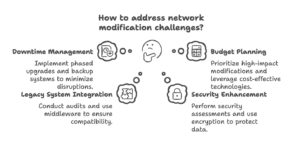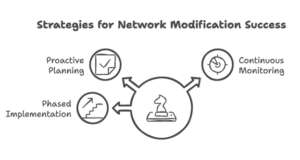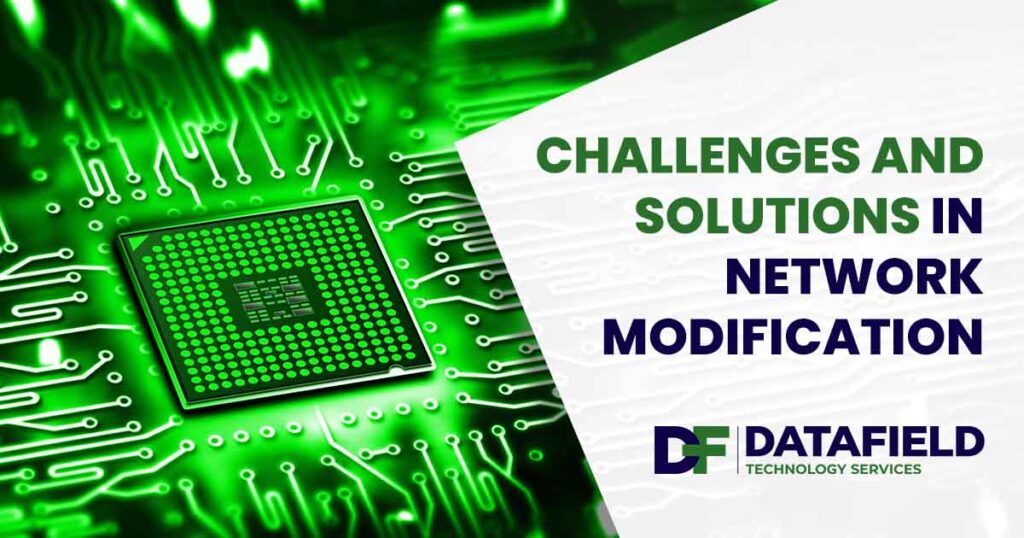Network modification projects are essential for improving performance, scalability, and reliability. However, they often come with unique challenges that require careful planning and innovative solutions. We explore the most common obstacles and actionable strategies to overcome them, ensuring your network modifications are efficient and impactful. Learn more about common network modification challenges and how we turn them into solutions.
Common Network Modification Challenges
Every network modification project has its unique hurdles. From technical issues to budget constraints, understanding these challenges is the first step to overcoming them effectively.

Downtime and Service Disruptions
Downtime and service interruptions can negatively impact user experiences and revenue. These issues often arise during maintenance and upgrades, making them a significant concern for organizations.
The Issue:
- Scheduled maintenance and unexpected issues during upgrades can lead to network downtime, affecting user experience and causing revenue loss.
Solution:
- Implement phased upgrades to limit the scope of disruptions.
- Use backup systems to ensure uninterrupted service during modifications.
- Schedule maintenance during off-peak hours to minimize impact.
Budget Constraints
Budget limitations are a frequent obstacle in network modification projects. Effective financial planning is critical to ensure projects stay within budget while delivering value.
The Issue:
- Network modifications often involve significant upfront costs, including hardware, software, and labor expenses.
Solution:
- Prioritize high-impact modifications that deliver the most value.
- Leverage cost-effective technologies like network virtualization to reduce expenses.
- Negotiate vendor contracts to secure bulk discounts and flexible payment terms.
Integration with Legacy Systems
Even with a thorough understanding of advanced network modification, legacy systems can complicate the integration of new technologies, leading to inefficiencies and delays. Addressing these compatibility issues is crucial for project success.
The Issue:
- Outdated infrastructure can complicate the integration of new technologies, leading to compatibility issues and inefficiencies.
Solution:
- Conduct a thorough audit of existing systems before implementation.
- Use middleware solutions to bridge compatibility gaps.
- Gradually phase out obsolete components to avoid operational risks.
Security Vulnerabilities
Security threats are a growing concern during and after network modifications. Protecting sensitive data and infrastructure should be a top priority.
The Issue:
- Modifying networks can expose vulnerabilities, making them susceptible to cyber threats during and after the upgrade process.
Solution:
- Perform a comprehensive security assessment before modifications.
- Use encryption, firewalls, and intrusion detection systems to safeguard sensitive data.
- Regularly update software to address potential vulnerabilities.
Regulatory Compliance
Compliance with industry regulations is non-negotiable in network modifications. Ensuring adherence to standards requires meticulous documentation and coordination.
The Issue:
- Adhering to industry regulations during network modifications can be complex and time-consuming.
Solution:
- Collaborate with legal and compliance teams early in the planning phase.
- Use compliance management tools to track regulatory requirements.
- Document all modifications to demonstrate adherence to standards.
Lack of Skilled Personnel
Network modifications often require specialized expertise. A shortage of skilled personnel can slow down progress and increase risks.
The Issue:
- Implementing advanced network modifications requires specialized expertise that may not be readily available in-house.
Solution:
- Invest in training programs to upskill existing staff.
- Partner with third-party experts or managed service providers.
- Use automation tools to reduce reliance on manual processes.
Strategies for Overcoming Challenges
Success in network modification projects often depends on strategic planning and proactive measures. The following strategies can help organizations address common challenges effectively.

Proactive Planning
Planning ahead is critical to identifying risks and developing solutions before challenges arise. A well-thought-out plan minimizes delays and cost overruns.
- Conduct a detailed risk assessment to identify potential challenges early.
- Develop contingency plans to address unforeseen issues.
Continuous Monitoring
Monitoring network performance throughout the modification process ensures early detection of issues and enables swift resolution.
- Use real-time monitoring tools to track network performance during and after modifications.
- Implement analytics to identify and resolve issues proactively.
Phased Implementation
Breaking projects into smaller phases reduces complexity and risk, allowing for thorough testing and adjustments at each stage.
- Break down large projects into manageable phases to reduce complexity and risks.
- Test each phase thoroughly before proceeding to the next.
Real-World Example: Overcoming Network Challenges
Real-world examples offer valuable insights into overcoming network modification challenges. These case studies demonstrate the effectiveness of strategic solutions.
A Success Story: 5G Integration
A global telecom provider faced integration issues while transitioning to 5G technology. By partnering with a managed service provider and using middleware solutions, they successfully:
- Reduced integration time by 40%.
- Minimized downtime with phased rollouts.
- Achieved compliance with regional regulations through detailed documentation.
Navigating Network Challenges with Confidence
Network modification projects come with inherent challenges, but with strategic planning and the right solutions, these obstacles can be effectively managed. By addressing downtime, budget constraints, legacy system integration, security, compliance, and skill gaps, organizations can ensure a smoother transition to advanced, reliable, and scalable networks.
For more insights on overcoming network challenges, contact DataField Technology Services by calling 614-847-9600.

